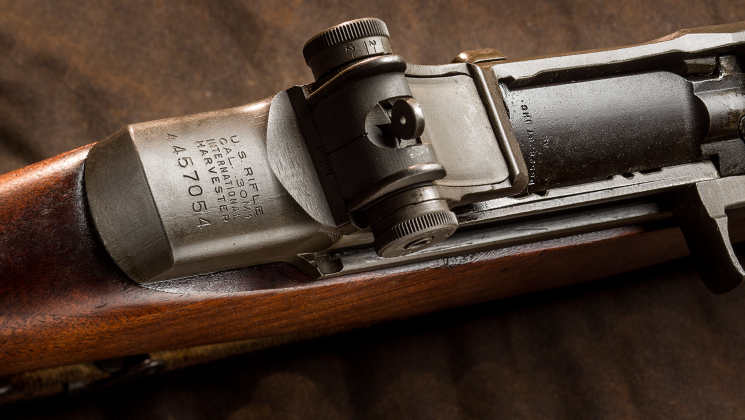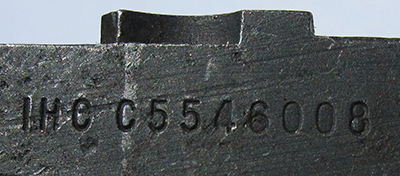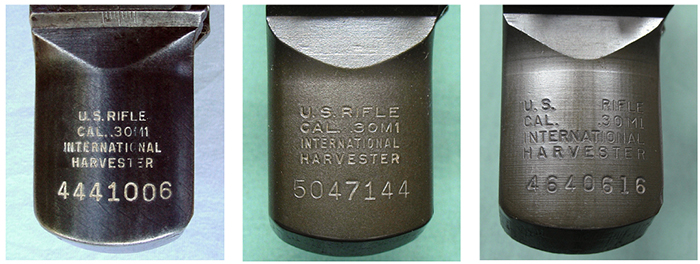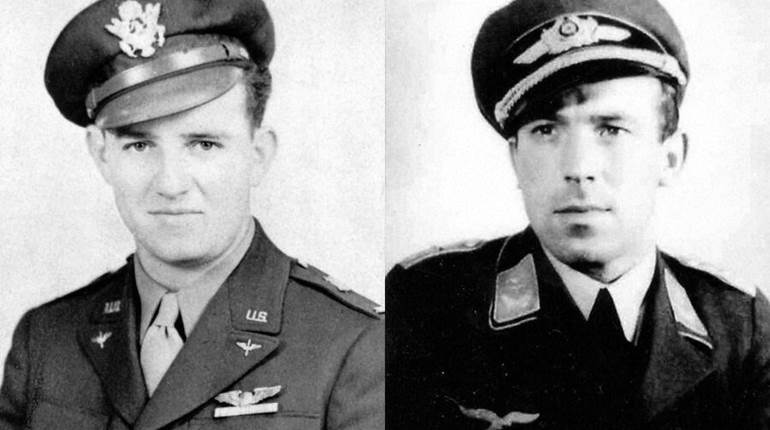
At the conclusion of World War II, the M1 Garand had garnered a well-deserved reputation as the best standardized service rifle of the conflict. Large numbers of Garands were in inventory after Victory over Japan Day, and it was assumed they were sufficient to meet the needs of our armed forces for the foreseeable future. Five years later, though, this illusion was shattered when hostilities commenced on the Korean Peninsula.
Many of the M1 rifles left over from World War II were taken from storage and refurbished for issue to troops departing overseas. To augment the supply of existing rifles, the U.S. Ordnance Dept. elected to put the M1 rifle back into production. Springfield Armory ramped up its Garand production line as quickly as possible, but additional sources were needed. As was often the case in previous wars, the government turned to civilian firms for production of all manner of military items, including firearms.

On June 15, 1951, the Ordnance Dept. granted a contract for 100,000 M1 rifles to the International Harvester Co (IHC). The rifles were to be manufactured at the firm’s Evansville, Ind., plant with deliveries scheduled to begin in December 1952. The Evansville facility was built during World War II by the Republic Aviation Corp. for production of the P-47 Thunderbolt fighter.
In 1945, International Harvester bought the former aircraft factory and converted it for manufacture of farm implements and refrigeration and air conditioning units. The selection of International Harvester was, to say the least, a rather interesting choice. Although the company manufactured vehicles—including half-tracks, trucks and tractors—during World War II, the firm had never made firearms, either civilian or military.
One of the major reasons behind the government’s seemingly unusual selection of International Harvester to produce M1 rifles was the plant’s geographic location. All of the more than 4 million M1 rifles that had been previously made by Springfield Armory and Winchester were manufactured within a radius of about 60 miles (the distance between Springfield, Mass., and New Haven, Conn.).
This may not have seemed important in the late 1930s or early 1940s, but the dawn of the Atomic Age put it in an entirely different perspective. Since most of the established armsmakers were in the New England area, a nuclear attack on the Eastern Seaboard could conceivably cripple the manufacture of military small arms in the United States.
The Department of Defense established a policy of geographic dispersion of vital defense production to mitigate vulnerability to a nuclear strike. The fact that Evansville, Ind., and Springfield, Mass., are more than 800 miles apart was seen as an important reason for selecting International Harvester to supplement Springfield Armory’s M1 rifle production.

Actually, the selection of a commercial enterprise that had never previously manufactured firearms for the military was not without precedent. During World War II, nine of the 10 prime contractors that manufactured the M1 carbine had never produced firearms before the war (the sole exception was Winchester). As was the case with the carbine manufacturers, plans were formulated for IHC to utilize a number of subcontractors to assist its Garand production program.
The serial number ranges assigned to IHC for M1 rifle production were: 4,400,000–4,660,000 and 5,000,501–5,278,245. In order to augment Springfield Armory’s and International Harvester’s M1 rifle production, a contract was also granted to the Harrington & Richardson Arms Co. on April 3, 1952, for the manufacture of 100,000 Garand rifles with additional contracts to follow.
As International Harvester began to gear up for M1 manufacture, the firm was immediately faced with a number of daunting challenges, exacerbated by the fact the company had no prior firearm-making experience. Since the company had expertise in making complex machinery, such as trucks and tractors, it assumed making rifles wouldn’t be any different.
It is reported that IHC’s management planned to make the Garand rifles using standard machine tools already on hand rather than acquire specialized firearm-making machinery and to begin delivering rifles by Christmas 1952. The firm soon found this was impractical. A large number of unexpected problems arose, which caused a lot of consternation and resulted in a significant delay in starting rifle production.

Other than the receiver, one of the most challenging M1 components to manufacture was the barrel, and production was subcontracted to the Line Material Corp. The Milwaukee-based firm was an established maker of various equipment used in the transmission of electrical and telephone lines and had a well-regarded engineering and manufacturing team. In addition to making barrels for use by International Harvester, Line Material also supplied a large number of M1 rifle barrels to various ordnance depots for use in rebuilding Garands.
It was soon widely acknowledged that the company’s barrels were of the highest quality. Line Material increased its capacity by adding a second shift to meet the demand for barrels for rebuilds and to supply IHC’s fledging Garand production program. It is reported that Line Material sent some barrels directly to ordnance units in Korea for use in overhauling M1 rifles in theater.
The barrels were marked “LMR” on the right side and were stamped with the drawing number (“D653448”), month and year of production, heat lot identification, “P” (proof) and “M” (magnetic particle inspection). Except for very early examples, the barrels made under subcontract for International Harvester can be identified by a punch mark between the “LMR” and the drawing number.

The high quality of the LMR barrels and their availability were among the few things to go smoothly with International Harvester’s M1 rifle production program. As IHC’s production problems became apparent, Springfield Armory dispatched John Garand’s chief tool and die maker, John Stimson, to Indiana to assist the company in setting up its production line. Once production was underway, a plethora of functioning glitches arose, including a serious jamming problem that completely shut down the assembly line for three months until the cause could be discovered and a remedy devised.
The company received assistance from both Springfield Armory and H&R (which was concurrently manufacturing M1 rifles by that time). Harrington & Richardson engineers eventually determined that the jamming problem was due to incorrect specifications for spring-tension settings. Other problems cropped up and were solved one by one, but IHC was never able to meet its contractual production schedule.
In order to help International Harvester get into Garand production as expeditiously as possible, a number of parts were procured from other sources. Interestingly, one of those parts was the most basic component of the rifle—the receiver. In addition to receivers actually made in house by IHC, the company utilized receivers made by Springfield Armory and H&R. There were four distinct variations of M1 receivers manufactured by Springfield for International Harvester.
SA/IHC “Arrowhead” Receivers
The first receivers made by Springfield Armory for International Harvester were in the approximate 4,440,000-4,441,100 serial number range and, for the most part, were consecutively numbered. Although marked “International Harvester,” the logo markings on the receiver were applied by Springfield Armory, and serial numbers were stamped at the IHC plant.
Most of these receivers were fitted with LMR barrels, although a few were fitted with Springfield Armory-made barrels. Collectors have dubbed this variant SA/IHC receiver as the “Arrowhead” due to the layout of the nomenclature markings which, with a bit of imagination, resemble an arrowhead with a broken tip.
SA/IHC “Postage Stamp” Receivers
Soon after rifles with the SA/IHC “Arrowhead” receivers started to be assembled, the previously mentioned problem with function-firing difficulties surfaced. Once the problem was identified and solved, IHC began using unfinished Springfield Armory receivers that were on hand. Rather than stamping the receiver logo markings with “arrowhead” format, IHC chose to stamp them with a format consisting of four even lines.
This variant is known as the “Postage Stamp” SA/IHC receiver. Like the “Arrowhead” receivers, these were stamped with the Springfield Armory drawing number (“D 652891”), revision numbers (“42” or “43”), and heat lot numbers indicating production by Springfield. Most of the rifles were assembled with LMR barrels (typically dated late 1952 or early 1953), but it is believed some Springfield Armory barrels (dated early 1953) were utilized as well.
SA/IHC 4.6 Million “Gap Letter” Receivers
The next variation of M1 rifle receiver supplied to International Harvester by Springfield was the so-called “Gap Letter” type in recognition of the noticeable space between the centers of the first two lines of the nomenclature logo. The reason for this change in the format of the nomenclature is not known.
SA/IHC 5 Million “Gap Letter” Receivers
The final variant of receiver made by Springfield Armory and supplied to International Harvester was the “Gap Letter” variety serially numbered in the assigned range 5,198,034 to 5,213,034, representing about 15,000 numbers. These receivers were acquired from SA by IHC to complete its production commitments.
HRA/IHC Receivers
To its credit, Harrington & Richardson did a great deal to assist International Harvester throughout the latter entity’s M1 production program. As IHC was winding down rifle manufacture, the company needed additional receivers to complete its production commitments. To this end, a relatively small quantity of M1 receivers (approximately 4,000) was supplied to IHC by H&R.
Those receivers fall into the approximate 5,213,034 to 5,217,065 serial number range. Interestingly, the logo nomenclature on them was apparently stamped by International Harvester (“Postage Stamp” profile) while the serial number and the drawing number on the receiver leg were applied by HRA.
Following is a summary of the type and quantity of M1 receivers manufactured for International Harvester by Springfield Armory and Harrington & Richardson:
SA/IHC “Arrowhead” 4,440,000–4,441,100...................1,100
SA/IHC “Postage Stamp” 4,441,000–4,445,600...800–900
SA/IHC “Gap Letter” 4.6 M 4,638,000–4,660,000...22,000
SA/IHC “Gap Letter” 5M 5,198,034–5,211,600..........13,243
HRA/IHC 5,213,034–5,217,065...........................................4,000

International Harvester-Made Receivers
Although Springfield and H&R supplied International Harvester with a number of receivers, the vast majority of the company’s M1 receivers were made by IHC. All of those were of the “Postage Stamp” variety. The receiver drawing number marked on the right side of the receiver leg was initially “IHC D6528291,” which was later changed to “D6528291” (no “IHC” prefix).
The majority of barrels used by International Harvester were made by Line Material (“LMR” marked), although some Springfield barrels were used, mainly very early and, again, near the end of the company’s M1 rifle production program.
The major components such as the bolt, operating rod, trigger housing, hammer, gas cylinder lock screw and rear sight windage and elevation knobs were generally marked “IHC” along with the appropriate drawing number and/or subcontractor initials. Although unmarked, IHC M1 front sights were typically characterized by the noticeably wider space between the two flared protective “ears,” approximately 0.875" across, wider than any other manufacturer.

As with many of the other components, the manufacture of stocks by International Harvester did not proceed as smoothly as originally envisioned. Initial plans were for IHC to make the stocks and fore-ends rather than using subcontractors—as was done for a number of other components. As events transpired, though, most of IHC’s stocks were manufactured by subcontractors, chiefly the S.E. Overton Co. A hallmark of IHC M1 stocks is the presence of numbers stamped in the “barrel channel.”
Although three-digit numbers have been reported, the overwhelming majority are four digits, sometimes with a letter prefix or suffix. These numbers are believed to represent a variation of the Julian dating system. International Harvester was the only manufacturer to utilize stocks stamped with such numbers. The profile of the stock behind the receiver heel on the IHC Garand was noticeably narrower than found on the contemporary H&R M1 stocks.
Early production IHC stocks were stamped with an Ordnance escutcheon emblem (“crossed cannons”) on the right side of the stock and a small—and often indistinct—“P” proof firing mark stamped on the bottom of the pistol grip. This was the only known case of a final inspection stamp on a post-war M1 rifle being applied to the right side of the stock.
Slightly later examples typically had the more commonly seen “circled P” proofmark (sans serif) applied to the face of the grip but still had the “crossed cannons” escutcheon stamped on either the left or right side. Circa October 1953, in the approximate 4.45 million serial number range, the “crossed cannons” stamp was replaced by a 1/2" Defense Acceptance Stamp on the left side of the stock.

International Harvester eventually accepted additional M1 production contracts totaling 418,443 rifles. Despite numerous setbacks and glitches experienced throughout the production program, the company worked diligently to overcome every obstacle put in its path, self-inflicted and otherwise. Just when it appeared that the company was going to successfully complete its M1 rifle production commitments, another complication arose.
In September 1955, IHC’s parent company negotiated a sale of the Evansville facility to the Whirlpool Corp. To add insult to injury, the sales contract mandated that Whirlpool take possession of the plant in January 1956. Since IHC had completed just over 300,000 rifles to date, it would have been impossible to finish the remaining 100,000 or so rifles called for in the contract in just two months’ time. This resulted in IHC having to negotiate an early “buyout” of the final contract. The following represents the total of rifles production from fiscal years 1953-1956:
Fiscal Year Quantity Delivered
1953 6,804
1954 82,897
1955 175,736
1956 72,186
Total 337,623

International Harvester’s M1 production program was obviously a source of consternation and almost continual headaches for the company. In hindsight, senior management (and likely stockholders as well) probably questioned the wisdom of getting involved in making military rifles. It was undoubtedly one of those, “It seemed like a good idea at the time” situations. Even though the company had to negotiate an early termination of its contract, it nontheless persevered and eventually made more than 337,000 M1 rifles by the time production ceased in December 1955.
The IHC people may not have been very proficient at making Garands but they can’t be accused of being quitters. Despite the numerous problems experienced by the company, an International Harvester M1 Garand is every bit as serviceable as those made by any other manufacturer. The International Harvester M1 has become one of the more popular examples of the genre among many collectors today due to the number of receiver variations and their relative scarcity as compared to Springfield Armory-made Garands of the same era.
Prior to the late 1970s, IHC M1s were rather hard to find on the domestic civilian market as compared to those made by other manufacturers. In the late 1950s and into the 1960s, many late-production Garands—especially Springfields and International Harvesters—were shipped to various countries under military foreign-aid programs. This accounts for the prior relative scarcity of the IHC rifles as well as Springfields in the very high number serial number range of 5.9 to 6.0 million.
While a few H&R Garands were also shipped to some allied nations, for some reason during this period, the bulk of these rifles seemed to be from International Harvester. Once the rifles were supplied to foreign governments, they could not be “re-imported” back into the United States for sale on the civilian market. Circa 1977-1978, a clause in the regulations permitted some of these former military rifles to be brought back to the United States, but sales were restricted to full-time law enforcement officers.
Quite a few rifles changed hands in this manner and, in the span of a couple of years, IHC M1s went from being quite scarce to being not particularly uncommon. The regulations were eventually tightened up to prohibit such sales, and the spigot was soon closed on the re-importation of IHC Garands. Not too many years later, the Director of Civilian Marksmanship and its successor, the Civilian Marksmanship Program (CMP), acquired significant numbers of Garands—including some IHCs—from overseas, and they were openly sold on to qualified buyers. As of this writing, the CMP periodically has IHC Garands available for sale.
Perhaps surprisingly, in light of the extensive production problems experienced with the M1 rifles, it has been reported that the Ordnance Dept. later approached International Harvester about the possibility of manufacturing M14 rifles under government contract. Perhaps not surprisingly, that did not come to pass. In hindsight, International Harvester likely wished it had stuck with making tractors instead of rifles. Regardless, an IHC M1 rifle is a sought-after collectible today and is a very interesting, albeit often confusing, part of the story of John Garand’s rifle.



















![Auto[47]](/media/121jogez/auto-47.jpg?anchor=center&mode=crop&width=770&height=430&rnd=134090788010670000&quality=60)
![Auto[47]](/media/121jogez/auto-47.jpg?anchor=center&mode=crop&width=150&height=150&rnd=134090788010670000&quality=60)















